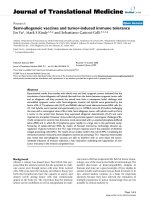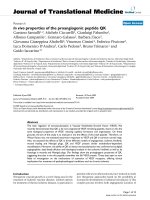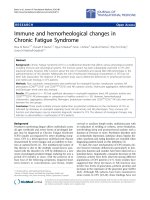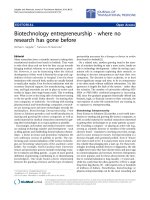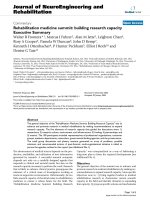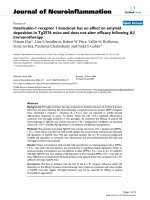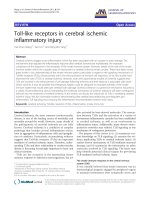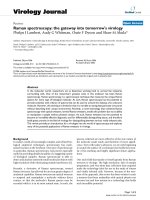Báo cáo hóa học: " Biotechnology entrepreneurship - where no research has gone before" pdf
Bạn đang xem bản rút gọn của tài liệu. Xem và tải ngay bản đầy đủ của tài liệu tại đây (173.66 KB, 2 trang )
EDI T O R I A L Open Access
Biotechnology entrepreneurship - where no
research has gone before
Michael L Salgaller
1*
, Francesco M Marincola
2
Editorial
Many researchers have a scientific interest in taking their
translational studies from bench to bedside. They want
to take their ideas and see how far they can go towards
bringing medical solutions to as many patients as possi-
ble. However, it can be frustrating when the clinical
development of their work is beyond the scope and cap-
abilities of their university or hospital. Even for those
institutions with research beds, studies are usually limited
to small, pilot studies. Even for those institutions with the
necessary financial support, the manufacturing, regula-
tory, and legal essentials are not in place to evolve such
studies to larger, late r-stage human trials. This is nothing
new. What is new is the rising tide of researchers turning
to the for-profit world. Either directly - by starting their
own companies, or indirectly - by working with existing
pharmaceutical and biotechnology companie s, research-
ers are moving more and more technologies towards the
marketplace. Biotechnology Entrepreneurship: From
Science to Solutions provides a real-world introdu ction to
starting and growing life science companies, as well as
useful material for medical researchers interested in get-
ting their technologies to as many patients as possible.
Increasingly, universities and medical research centers
are making technology transfer and development - such
as filing patents and establishing formal industry relation-
ships - a factor in tenure and promotion evaluation; the
new millennia version of publish or perish. The out-
lice nsing and commercialization of life science technolo-
gies are becoming valued parts of the academic career
ladder. For example, North Carolina State University
tenure and promotion process includes technology trans-
fer to industry and filing patents - as part of more general
definition of generating, contributing to, or disseminating
knowledge[1]. One study found a direct relationship
between the granting of tenure and the type of industry
partnership necessary for a therapy or device to evolve
from bench to bedside[2].
On a related note, anot her growing trend is the num-
ber of scientists deciding to take a more active, hands-on
role in technology development - either by serving a pro-
minent role in companies exploiting their research, or
deciding to become entrepreneurs and start their own
companies. The decision to leave academia, or at least
divert significant energy and time, to be an entrepreneur
is too often made without sufficient information. Yet, this
ignorance is largely the fault of the system - rather than
the scientist. The number of universities offering MD/
MBA or PhD/MBA combined programs is increasing.
Still, since few graduate programs historically offered any
business, legal, or financial courses in their curricula, the
vast majority of active life scientists have any training in,
or exposure to, entrepreneurship.
Biotechnology Entrepreneurship
From Science to Solutions [3] provides a real-world intro-
duction to starting and growing life science companies, as
well as useful material for medical researchers interested
in getting their technologies to as many patients as possi-
ble. Foundin g a company - or playin g an active role (e.g.,
serving as scientific director or member of the scientific
advisory board - translates to investing your time, energy,
and (in some instances) money. Entrepreneurship is a
decision fraught with potential peril[4]. Even if “ tenure
isn’t what it used to be,” it is many times more secure and
less volatile than plunging into a start-up. For those tech-
nologies involving medical devices or diagnostics, the risk
is slight lower since they have shorter times and price-tags
to commercialization and revenues. However, therapeutics
are more popular, and for these advancements the time-
line to commercialization is long (usually > 5 years) and -
while less costly than the often-quoted $1-1.7B for a single
drug from big pharma [5] - still requires tens or hundreds
of millions of dollars. Nonetheless, biotechnology or
pharma entrepreneurship can be the most rewar ding and
* Correspondence:
1
thinkBiotech, LLC, Washington, DC 20009, USA
Full list of author information is available at the end of the article
Salgaller and Marincola Journal of Translational Medicine 2010, 8:102
/>© 2010 Salgaller and Marincola; licensee BioMed Central Ltd. This is an Open A ccess article distributed under the terms of the Creative
Commons Attribution License ( which permits unrestricted use, distribution, and
reproduction in any m edium, provided the original w ork is properly cited.
challenging pursuits in a research career - and one of
increasing interest and activity.
Thus, today’s medical researchers are helping new thera-
pies, devices, and diagnostics address unmet and under-
served medical needs in record numbers and in record
time. The y are taking to understanding the busi ness side
of product development with the same zeal w ith which
they first learned scientific principles. It is great to observe
PhDs and MDs so readily admit and address (by leaving
well-established comfort zone) their lack of understanding
of that business side. Never afraid to ask challenging scien-
tific questions, they are taking that “why not?” attitude to
the for-profit wo rld. Collaborations previously limited
other academi cs are being expanded to encompass tech-
nology transfer, intellectual property, balance sheets, and
even mar keting. Titles such as “CEO” and “Founder” are
becoming common additions to “professor” and “tenured.”
Scientists can be just as successful building companies as
they are in building research programs. Oh, and by the
way, entrepreneurship creates jobs and helps the economy
as well not a bad by-product!
Author details
1
thinkBiotech, LLC, Washington, DC 20009, USA.
2
Infectious Disease and
Immunogenetics Section (IDIS) - Department of Transfusion Medicine,
Clinical Center, National Institutes of Health, Bethesda, MD 20892. USA.
Received: 4 October 2010 Accepted: 15 October 2010
Published: 15 October 2010
References
1. NCSU Policies, Regulations, and Rules: [ />employment/rpt/RUL05.67.302.php].
2. Allen DStuart, Link NAlbert, Rosenbaum TDan: Entrepreneurship and
human capital: evidence of patenting activity from the academic sector.
Entrepreneur 2007 [ />170729966_3.html].
3. Salgaller LMichael: “Biotechnology Entrepreneurship: From Science to
Solutions.”. Logo Press. New York 2010.
4. Peter Kolchinski: The Entrepreneur’s Guide to a Biotech Start-up.,4
[].
5. Janodia DManthan: Drug Development Process: A Review. 2007 [http://
www.pharmainfo.net/reviews/drug-development-process-review].
doi:10.1186/1479-5876-8-102
Cite this article as: Salgaller and Marincola: Biotechnology
entrepreneurship - where no research has gone before. Journal of
Translational Medicine 2010 8:102.
Submit your next manuscript to BioMed Central
and take full advantage of:
• Convenient online submission
• Thorough peer review
• No space constraints or color figure charges
• Immediate publication on acceptance
• Inclusion in PubMed, CAS, Scopus and Google Scholar
• Research which is freely available for redistribution
Submit your manuscript at
www.biomedcentral.com/submit
Salgaller and Marincola Journal of Translational Medicine 2010, 8:102
/>Page 2 of 2
